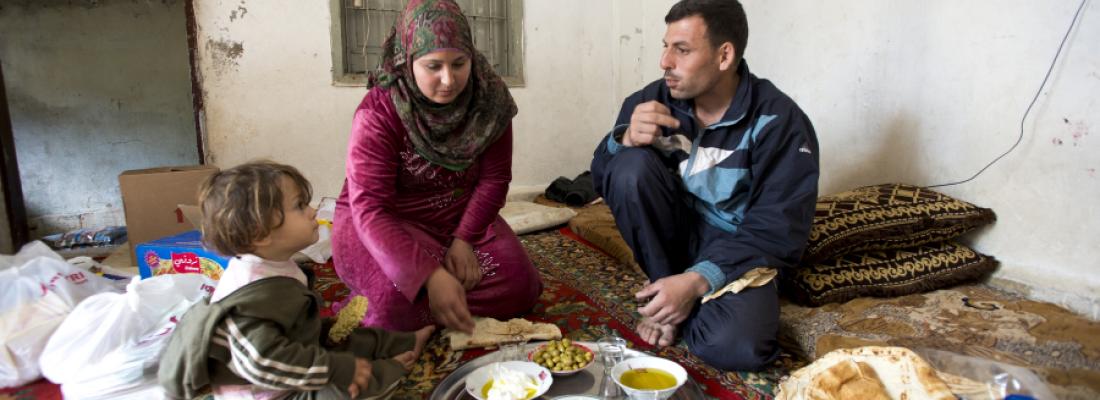Society and regional strategies 5 min
Targeting food aid for vulnerable populations more effectively
PRESS RELEASE - With uncertain future budgets for United Nations food aid, food security for refugee populations can only be achieved when aid is carefully targeted and effective. INRA researchers and their colleagues recommend taking simultaneous account of both individual and regional- and community-level data to effectively identify households facing food insecurity and/or economic vulnerability. Their research, published in the April issue of Food Security offers new possibilities for shaping food policy.
Published on 13 April 2018

The fight against world hunger must recognise the fundamental right of vulnerable people to access sufficient, safe and nutritious food that meets their dietary needs and food preferences for an active and healthy life (World Food Summit 1996). With more than 22.5 million refugees in the world today (HCR 2016) and uncertainty surrounding the funding of international food aid programmes, food security for vulnerable people has become an increasingly pressing policy issue. When aid is distributed, those households whose food or economic needs and vulnerabilities are the greatest must be prioritised.
Researchers at INRA, working with their colleagues at the American University of Beirut, studied the mechanisms used by United Nations agencies to distribute aid to vulnerable refugee populations. Their aim was to improve targeting processes to identify the most vulnerable households with greater precision and lower costs, thereby limiting leakage (aid to non-vulnerable households) and under-coverage (failure to identify vulnerable households). They used United Nations data on the more than one million Syrian refugees in Lebanon receiving assistance from the World Food Programme (WFP) to develop a model to identify vulnerable households.
The research team found that the simultaneous consideration of individual data and regional and community-based aggregates (access to drinking water and sanitation facilities, access to healthcare, incidence of chronic disease) improves the overall targeting effectiveness of aid programmes for vulnerable populations.
When poverty rather than food insecurity — which is difficult to assess with precision — is used as a indicator, targeting effectiveness is higher. Coverage rates reached 85%, compared to 54% when referencing food insecurity.
The model combining both individual and aggregate data thus provided the best overall performance in terms of targeting effectiveness: more vulnerable households were covered while leakage was reduced. There was a global gain of 9% over existing practices.
The work presents an original method that combines individual and larger-scale community aggregate data to reduce instances of food aid being misallocated and to increase the targeting effectiveness for populations that are food insecure and/or economically vulnerable. The work also has the potential to reduce costs associated with data collection because developing aggregate data indicators is less intensive than collecting data on households. When aid is better targeted it can only be more effective. The model creates opportunities for analysts and policymakers to consider new models for aid distribution, food aid in particular.
Researchers used data from the Vulnerability Assessment of Syrian Refugees in Lebanon (VASyR), jointly prepared by the United Nations High Commissioner for Refugees (UNHCR), the United Nations International Children’s Fund (UNICEF) and the World Food Programme (WFP). The Assessment collected data from a representative sample of refugee households. VASyR 2015 collected data from 4,100 households, representing some 21,300 individuals. The Assessment looked at the households’ demographics, their means of subsistence, expenses, food consumption, child nutrition, food insecurity, protection, housing, possessions, health, education and other criteria. Researchers also used data from the UNHCR’s Profile Global Registration System (ProGres) database which in 2015 contained registration information on over one million refugees. Using the VASyR 2015 data, they selected two indicators — the food consumption score and the reduced coping strategy score — which they combined to better assess food insecurity. Using individual data, they calculated community-level indicators (access to drinking water and sanitation facilities, access to healthcare, incidence of chronic disease, etc.). Finally, they determined the statistical relationship between food insecurity and poverty so that poverty could be used to better explain food insecurity.
|
REFERENCE Targeting mechanisms for cash transfers using regional aggregates Chaaban J., Ghattas H., Irani A. et Thomas A. Food Sec. (2018) 10: 457. https://doi.org/10.1007/s12571-018-0768-5 |
